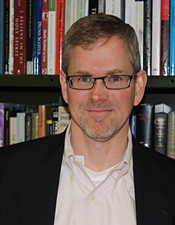READ THIS BOOK – October 2015
Each month, we ask a member of the Vanderbilt Divinity School faculty to recommend a book they are currently reading. Our October recommendation is offered by Paul DeHart, Professor of Theology and Chair, The Graduate Department of Religion.
Peter Brown, Through the Eye of a Needle: Wealth, the Fall of Rome, and the Making of Christianity in the West, 350-550 AD (Princeton University Press, 2012)
We are often startled by the pace of urban change, and by the feebleness of our memories of even the most familiar neighborhoods. Just two years ago a building was there, a building that had stood perhaps for fifty years. Yet we cannot for the life of us remember now what it looks like. Imagine you had to return to some area you knew well twenty or forty years ago; you might arrive confident that your memories would guide you to all the old familiar places, but soon you would find that a map has become indispensable. When we translate this experience to the realm of history, we get a pretty good sense of the challenge facing historians: the past, the saying goes, is a foreign country. We may think we know it fairly well, but when we get down to details we realize all too quickly that the random collection of dates and images we associate with a period do little if anything to guide us in learning how the society actually worked and what the people of that time and place took for granted in their thinking and acting (and hence, also, what we take for granted).
Peter Brown has written a magnificent book about a period in history that sometimes we think we know a bit about, 350-550 C.E., when the imperial structure in Western Europe petered out, or rather was taken over by the successors of Peter in a transition to something like early medieval society. Perhaps we have read about the “fall of Rome” and its military and economic causes; perhaps we have read a few sermons by Ambrose, or a few letters of Jerome; many will know Augustine’s lively Confessions. But these bits of the past, which seem familiar at first, need historical contextualization to be grasped fully, and this is where our uninformed imagination fails us. We think we know what we mean when we say that the “Roman Empire collapsed”, or that “the Catholic Church rose” to become the dominant cultural force. But Brown is here to teach us how much we have to learn, and also that much we think we know is not quite right.
The focus of his book is on wealth; for it was not the conversion of Constantine that marked the real point of transition toward a recognizably “Christian” society, but rather what began to happen some sixty or seventy years later: the large scale migration of the elite social strata into the church. Brown looks at a series of figures, some familiar like the Church Fathers named above, some less so (Symmachus, Ausonius, Paulinus of Nola) in order to track the varied stances of leaders in this period toward money, poverty, and the relation of Christian faithfulness to the mechanisms of governance and the stratification of classes. Brown is immensely learned about this era, yet writes in a delightfully clear and vivid style. When Christians speak in this period about “wealth” and “poverty” we may think such terms have a timeless meaning, but Brown gives us different eyes, conducting us through the “foreign country” of late antique Rome in order to see how differently these writers thought about these matters than we do. Along the way, he raises some intriguing questions about the role of Christianity’s rise in the fall of Roman society. But also, for me at least, his book invites us to think anew about the nature of faith as a historical and social force, both in the past and in our own day.

